Collectible Canadian 1982 Pattern Web Equipment

1982 Pattern Web Equipment was the last major type of web equipment to be issued to the Canadian Army in the 20th Century, and with the advent of the Tactical Vest in the 21st Century, may possibly be the last type of web equipment ever issued to Canadian soldiers.

History
The stated intent of the 1982 Pattern Web Equipment gear was to provide a more flexible and effective system of equipment in response to requests from troops in the field. The new gear was developed using lighter and more durable water repellent fabrics, along with nylon buckles, couplings and quick release features, and was evaluated in extensive user trials.
The 1982 Pattern Webbing, as it was also known, incorporated the design principles of NATO STANAG 2311, and meant to be used in full or partial sets as Fighting Order, Battle Order, or Marching Order. The gear was a modular system, with Fighting Order used as a basic building block (not unlike earlier sets of web equipment) to which the system could be tailored to meet specific mission requirements. To meet this end, the manual also indicates that a "mission analysis of all known users of personal webbing" was conducted, to determine which components would be essential for these missions, and determined the initial issue of these components.
Studies made during the development of the gear were undertaken by Mobile Command, the Defence and Civil Institute of Environmental Medicine (DCIEM), the US Army Natick Laboratories, and the Directorate of Clothing General Engineering and Maintenance (DCGEM). These studies, as well as other studies, were the genesis of several load carrying principles:
-
Soldiers can carry loads of up to one third their body weight for prolonged periods with little adverse effect
-
Soldiers can carry loads in excess of one third their body weight, however the effect of so doing is cumulative and directly proportional to the increase in weight and the time carried
-
Loads should be positioned high on the back and as close to the body as possible
-
Loads should be carried so as to distribute the weight between the hips and shoulders in the ratio of 60 to 40 percent respectively.
These were the guiding principles for the development of the 1982 Pattern Webbing. The gear was was also designed from the proposition that carrying combat loads would be made more difficult by improper carriage, and that every item had to have a proper place, or in other words, location was important. It was felt the most critical items of equipment should be the easiest to reach.
The load carriage rules that the manual proposed were:
-
Know the equipment
-
Assemble the equipment properly
-
Keep each item in its proper place
-
Keep the load as light as possible.
In general, the 1982 Pattern Webbing was seen as an improvement over the previous set of load bearing equipment, 1964 Pattern, not least of all because of the provision of ammunition pouches. The padded yoke was also a departure from previous sets. Rather uniquely, a pouch was provided for the issue Knife, Fork and Spoon (always referred to simply as a "KFS") which also had a pouch for the issue C5 Utility knife (or private-purchase Swiss Army knife which was similar in size). The older metal mess tins were also replaced (as the dangers of aluminium poisoning became well known) with a "melmac" plastic plate and cup. The older metal water bottles were replaced with lightweight plastic canteens of US design, with initial patterns being a plain bottle and newer models having an adaptor on the head to enable the water bottle to be used in conjunction with a gas mask.
The rucksack, however, was not popular, despite some improvements over the 1964 rucksack, such as a padded back protector. Chief complaint was the attachment points of the sleeping bag to the bottom of the rucksack, providing a lower centre of gravity; many soldiers continued to use the 1964 rucksack, or at the least the 1964 rucksack frame, and its top-mounted sleeping bag. New soldiers very often privately purchased 1964 pattern rucksacks rather than use the 1982 model.
New developments to the webbing included the replacement of FN C1 magazine pouches with similar pouches of a different size to accommodate the C7 and C8 rifles taken into service in the late 1980s.
Orders of Wear
Fighting Order
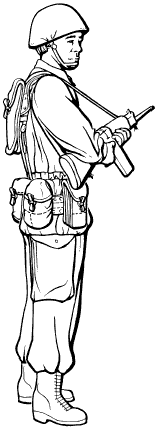
Fighting Order was intended as the basic building block of this equipment. Fighting Order was intended only to provide for a soldier's immediate needs in action. It ensured freedom of movement for the soldier, ease of access and use, and allowed him to carry vital equipment.
Different units developed different standards of what should be carried, but at the minimum, the set provided for the carriage of 4 magazines of rifle ammunition, a plastic water bottle and a utility pouch (in which ammunition, grenades, or more likely the soldier's raingear could be stored), as well as KFS, bayonet, and possibly a gasmask in a separate carrier, slung over the shoulder and worn underneath the webbing.
Note in the illustration at right how the webgear is slung low, over the hips, rather than resting on the hip bones. This was the preferred method of wearing this gear.
This order would not sustain the soldier in action for extended periods of time and would be appropriate for very specific missions of short duration.
Battle Order
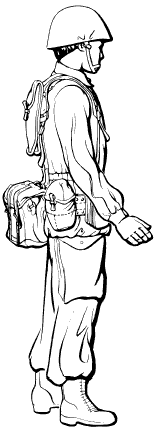
Battle Order was similar to Fighting Order, but allowed for the carriage of extra ammunition, equipment, and rations, and conceivably allowed a soldier to carry enough necessities to sustain him in battle for periods of approximately 24 hours. The gear was changed by the addition of a "small field pack" which could be attached to the webbing, or alternately slung over the shoulder. The small field pack was widely referred to as a "butt pack" due to its preferred location directly on the back of the gear, over the buttocks. The melmac plate and cup could be carried in this pouch, along with rations and additional ammunition, though access to this pouch required removal of the web gear. The utility pouch could be utilized for such things as grease pencils, a field message pad in a zippered cloth cover, sticks of face camouflage, earplugs, magazine chargers (though these were often seen tucking into the e-tool attachment points on the yoke), etc.
At least one unit issued out a second small field pack for the carriage of NBC suits
Marching Order
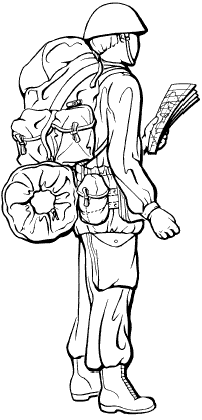
Marching Order was achieved by the addition of the rucksack, and was intended to get a soldier and enough equipment to sustain him in the field indefinitely from place to place (on foot, if necessary, but also in as compact a manner to enable movement by various types of vehicles.)
The rucksack could carry additional rations, as well as changes of clothing, spare socks, underwear, as well as the soldier's windproof pants, liner for his combat coat (if not worn in the coat), sweater, shave and wash gear (if not carried with his Battle Order), sewing kit, "winter whites", and his sleeping gear (a two part down-filled sleeping bag, flannel liner, and black air mattress, replaced in later years with self-filling green air mattress and augmented with a Gore-Tex "bivvy bag"). A groundsheet was also carried, either to lay underneath the sleeping gear if bivouacked in tents, or to construct make-shift shelters (popularly known as "hoochies").
One major design inconvenience with Marching Order was that unlike, for example, 1937 Web Equipment, the rucksack could not be comfortably worn in conjunction with Battle Order due to the small field pack's attachment to the utility belt. The often seen solution was to take the web gear and attach it externally to the rucksack before donning Marching Order.
The rucksack also had attachment points for large entrenching tools (full size spades and picks), snowshoes, or skis. There was also an internal pouch to accommodate the PRC 77 radio (77 Set)
Components
- Utility Belt
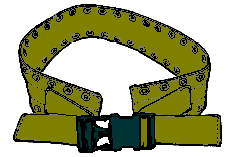
- Yoke
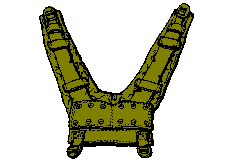 The padded yoke was used to support the Utility Belt, and also had eyelets on the back, generally used to attach the entrenching tool carrier.
The padded yoke was used to support the Utility Belt, and also had eyelets on the back, generally used to attach the entrenching tool carrier.
- Hook-Strap Assembly
 Similar in purpose to the Brace Attachments of the 1937 Web, these items hooked on to either the utility belt using plastic hooks designed to fit into the eyelets, or a flap with eyelets on the ammunition pouches, and then the opposite end buckled into the Yoke. Two sets were also used in the rear, generally either attached to the utility belt or the small field pack.
Similar in purpose to the Brace Attachments of the 1937 Web, these items hooked on to either the utility belt using plastic hooks designed to fit into the eyelets, or a flap with eyelets on the ammunition pouches, and then the opposite end buckled into the Yoke. Two sets were also used in the rear, generally either attached to the utility belt or the small field pack.
- Carrier - KFS
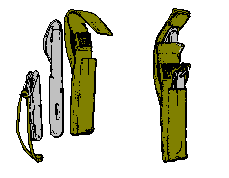 The Knife-Fork-Spoon set was carried in this pouch, with a separate pocket for a C5 pocket knife (or private purchase Swiss Army knife or similar tool).
The Knife-Fork-Spoon set was carried in this pouch, with a separate pocket for a C5 pocket knife (or private purchase Swiss Army knife or similar tool).
-
Scabbard Bayonet Holder
 More commonly known as a "frog", this web item differed little from earlier patterns, and was used to secure the Bayonet. The FN bayonet frog was in cotton webbing while the C7 frog was in nylon. Only issued to those whose duties required use of the bayonet. The frog simply looped over the utility belt; the bayonet scabbard was retained by a lug on the outside of the scabbard, and the bayonet handle was secured by a strap and snap fastener.
More commonly known as a "frog", this web item differed little from earlier patterns, and was used to secure the Bayonet. The FN bayonet frog was in cotton webbing while the C7 frog was in nylon. Only issued to those whose duties required use of the bayonet. The frog simply looped over the utility belt; the bayonet scabbard was retained by a lug on the outside of the scabbard, and the bayonet handle was secured by a strap and snap fastener.
- Magazine Pouch
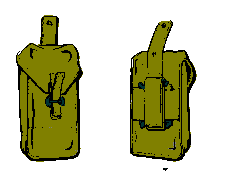 Pouches for the FN C1 magazines and the C7 were similar, with two magazines per pouch. The pouches had lifting tabs for the magazines, which fit snugly inside. The pouches attached to the utility belt with a wrap-around velcro strap, and also through use of four plastic hooks which attached to the eyelets. There was also a strap on the top of the pouch to attach to the Hook-Strap assembly. The pouches were closed by a cotton webbing tab which tucked into a plastic buckle, and intended only to be issued to those whose personal weapon was a rifle. Larger pouches were also provided for the FN C2 (though a chest harness was also available for C2 gunners).
Pouches for the FN C1 magazines and the C7 were similar, with two magazines per pouch. The pouches had lifting tabs for the magazines, which fit snugly inside. The pouches attached to the utility belt with a wrap-around velcro strap, and also through use of four plastic hooks which attached to the eyelets. There was also a strap on the top of the pouch to attach to the Hook-Strap assembly. The pouches were closed by a cotton webbing tab which tucked into a plastic buckle, and intended only to be issued to those whose personal weapon was a rifle. Larger pouches were also provided for the FN C2 (though a chest harness was also available for C2 gunners).
- Canteen Carrier
 The official manual refers to this as a Canteen Carrier, though the Canadian term "water bottle" is generally considered more appropriate. The water bottle nested into a metal canteen cup which could be used for boiling water to make hot tea, juice crystals, etc. and both were then placed in the carrier. The carrier could also be used to carry later patterns of thermos. The carrier attached to the utility belt in the same manner as the magazine pouches - a velcro flap, and four plastic hooks, and secured closed with a cotton webbing tab tucked into a plastic buckle.
The official manual refers to this as a Canteen Carrier, though the Canadian term "water bottle" is generally considered more appropriate. The water bottle nested into a metal canteen cup which could be used for boiling water to make hot tea, juice crystals, etc. and both were then placed in the carrier. The carrier could also be used to carry later patterns of thermos. The carrier attached to the utility belt in the same manner as the magazine pouches - a velcro flap, and four plastic hooks, and secured closed with a cotton webbing tab tucked into a plastic buckle.
- Utility Pouch
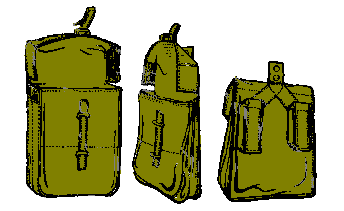 The utility pouch was originally intended for spare ammunition, rain gear, etc. With the adoption of the C9 LMG in the late 1980s it could also be used to carry 200 rounds of ammunition for that specific weapon, and is referred to in later editions of the manual as a Pouch Magazine Utility, 200 Round. The pouch attached with velcro straps as well as two sets of 4 plastic hooks.
The utility pouch was originally intended for spare ammunition, rain gear, etc. With the adoption of the C9 LMG in the late 1980s it could also be used to carry 200 rounds of ammunition for that specific weapon, and is referred to in later editions of the manual as a Pouch Magazine Utility, 200 Round. The pouch attached with velcro straps as well as two sets of 4 plastic hooks.
- Gas Mask Carrier - C4, NBC
![]() The gas mask case carried both the mask itself as well as decontaminant equipment and detectors. The carrier could be attached to the webbing via two sets of four plastic hooks as well as velcro straps, however the optional shoulder straps permitted it to be slung under the webbing, which was more convenient for most soldiers.
The gas mask case carried both the mask itself as well as decontaminant equipment and detectors. The carrier could be attached to the webbing via two sets of four plastic hooks as well as velcro straps, however the optional shoulder straps permitted it to be slung under the webbing, which was more convenient for most soldiers.
- Pistol Holster
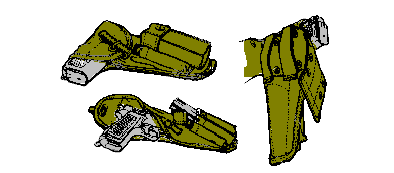 The pistol holster was used for the issue 9mm Browning and also included storage for an additional magazine of ammunition as well as cleaning supplies.
The pistol holster was used for the issue 9mm Browning and also included storage for an additional magazine of ammunition as well as cleaning supplies.
- Combat Shovel Carrier
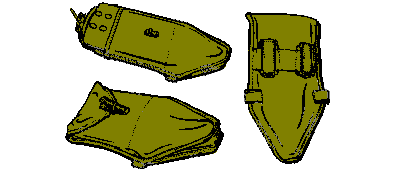 A case for a folding entrenching tool was also provided in 1982 Webbing, generally affixed to the top of the yoke by two sets of four plastic hooks.
A case for a folding entrenching tool was also provided in 1982 Webbing, generally affixed to the top of the yoke by two sets of four plastic hooks.
- Small Field Pack
 More commonly known as the "butt pack", this bag attached to the back of the utility belt, or could be worn slung on the integral shoulder strap. It secured closed by two FASTEX buckles, and also had an internal drawstring at the top, underneath the flap.
More commonly known as the "butt pack", this bag attached to the back of the utility belt, or could be worn slung on the integral shoulder strap. It secured closed by two FASTEX buckles, and also had an internal drawstring at the top, underneath the flap.
- Large Field Pack
Commonly known as a "rucksack", the large field pack consisted of a frame, a bag with main compartment, a smaller compartment for the PRC 77 radio (77 Set), a flap with internal pocket, and three external pockets as well as attachment points for skis, snowshoes, or entrenching tools. At the bottom of the frame were attachments for fitting the sleeping bag valise (with contents including, according to timeframe and unit SOP, two part sleeping bag, sleeping bag hood, sleeping bag liner, groundsheet, bivvy bag, and steel or kevlar helmet.)
Set Up
- Fighting Order
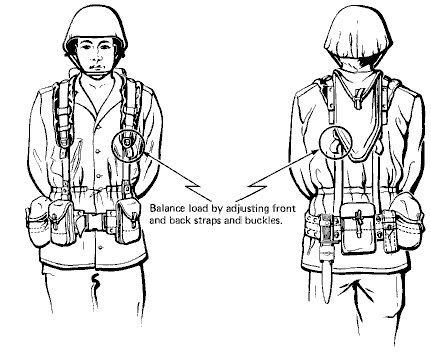
In its "official" form was set up as shown at right; the utility belt had a thread indicating the exact centre of the belt, to which the utility pouch was to be aligned with. Note the position of the belt on the hips rather than the waist.
Some soldiers often taped a field dressing to the upper part of the yoke, depending on unit SOPs; another common placing was on the belt itself. "Ranger beads", used for pacing, were also a common site on the yoke. The anglehead flashlight could also be clipped to the yoke.
- Battle Order
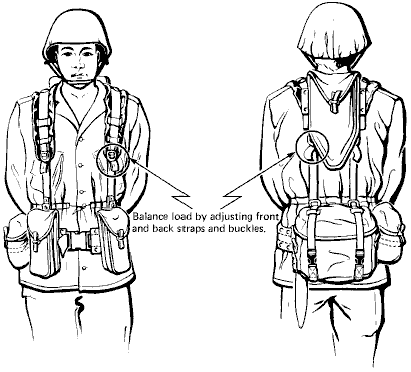
Was significantly different and probably most commonly encountered in the field. At least one reserve infantry unit issued out one basic pouch from the 1951 Pattern webbing as an additional method of load carrying, additional to both the small field pack and the utility pouch of the 1982 Pattern Webbing.
- Marching Order

Consisted of all the items a soldier might need in the field for an indefinite period of time.
Additional, or "follow up" kit might additionally be carried when changing station in the kit bag, and then stored with unit transport, carrying such items as PT kit, civilian clothes, additional cold weather items, rubber over boots, bath towel, shower shoes, etc.
The official manual also gives a couple of suggested alternate setup configurations for the webbing
















